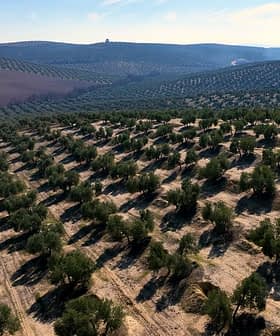Spain’s leading agricultural union has predicted that olive oil shortages may occur in the world’s largest-producing country in the second half of the 2023/24 crop year, which ends in September.
Cooperativas Agro-Alimentarias said the latest data published by the Ministry of Agriculture, Fisheries and Food indicate that the 560,000 tons of olive oil supply to the market will be insufficient to cover domestic demand and exports until the next harvest.
There will be enough olive oil stocks to reach the start of the campaign, but this will all be virgin olive oil, and there will be almost no extra virgin olive oil left.
The union cited consecutive years of poor harvests – Spain produced 846,800 tons in 2023/24 and 665,800 tons in 2022/23 compared to the average of 1.4 million tons from the previous five crop years – combined with low yields elsewhere in the Mediterranean basin and the continued prohibitions on bulk exports from Turkey and Morocco for the current situation.
Cooperativas Agro-Alimentarias estimates that monthly consumption and exports cannot exceed 90,000 tons if the current stock lasts until the next crop year.
See Also:European Olive Oil Supply Hits Decade-LowIn the last five months of the previous four crop years, exports and domestic consumption only fell below 90,000 tons in August 2023, a moment in which leading experts voiced their concerns about olive oil shortages.
Among them was Juan Vilar, a strategic consultant for the sector. However, he currently disagrees with Cooperativas Agro-Alimentarias and anticipates there will be enough olive oil to meet demand ahead of the next harvest.
“There is enough olive oil. There will be no shortage,” he said. Based on current market conditions, he estimates there will be up to 120,000 tons of olive oil stocks in Spain and 260,000 tons globally at the end of 2023/24.
“In the Northern Hemisphere, 65 percent of olive oil consumption takes place at home,” Vilar said. “From this moment of the [crop] year onward, more people tend to eat outside of the home in restaurants or order delivery.”
Additionally, he pointed out that Mediterranean countries are seeing an increase in the consumption of other edible oils, specifically sunflower oil.
Instead, Vilar said a shortage of extra virgin olive oil is more likely but believes there will be just enough to make it to October when the early harvest begins.
“There will be enough olive oil stocks to reach the start of the campaign, but this will all be virgin olive oil, and there will be almost no extra virgin olive oil left,” he said.
Frankie Gobbee, the co-founder and chief executive of Argentina Olive Group, Argentina’s largest producer and supplier of major Spanish brands, believes Spain will not be the only country to experience extra virgin olive oil shortages this year or in the coming crop years.
Gobbee said the global olive oil availability, total sales in the current campaign, and harvest prospects for 2024/25 indicate there may be shortages.
“Global production will be somewhat lower than initially estimated,” he said. “We estimate a global production of 2,105,000 tons and an availability of 2,505,000 tons. We are talking about 11.7 percent less oil than last season and 29.6 percent below 2021/22.”
The second consecutive year of poor global production will impact all grades of olive oil. A shorter and generally faster harvest produced less lampante olive oil.
Meanwhile, a poor harvest in Greece means less extra virgin olive oil available for local and Italian bottlers.
Lower-than-expected harvests in Algeria, Israel, Lebanon, Morocco, Palestine and Turkey, along with anticipation of poor harvests in the three leading Southern Hemisphere exporters – Argentina, Chile and Peru – have further complicated the situation by restricting the supply for bottlers and curbing bulk exports.
“Clearly, we have a market with less oil than last season and much less than in the 2021/22 campaign, together with a greater concentration in the hands of Spanish producers,” Gobbee said.
Reduced production will result in decreased global olive oil sales. “The lower availability forces lower consumption, 12 percent less than in the previous year and 30 percent less than in 2021/22,” Gobbee said.
However, he emphasized that decreasing consumption is due to lower production, not vice versa.
Vilar agreed. “Potential demand was greater than actual supply, so there was an increase in prices such that potential demand has been falling until it has balanced with real supply,” he said.
“Now that it is going to happen in anticipation of the next campaign worldwide, it is very likely that there will be three million tons, then the opposite situation will occur because the potential supply will be greater than the real demand,” he added.
While global olive oil prices at origin have fallen from their mid-January record highs, they remain more than double what they were two years ago.
“Prices are going down little by little except for extra virgin. When the campaign starts, depending on what the campaign is like, it will go down faster,” Vilar said. “And the faster olive oil production grows, the faster the price will fall until a balance is produced between real supply and potential demand.”
Still, Gobbee and Vilar anticipate prices will remain relatively high compared to the average in 2021/22 through the middle of the coming crop year and possibly beyond.
According to the latest data from Infaoliva, extra virgin olive oil prices have been on the rise since the start of April, when prices fell to their lowest point in 2024, climbing from €7.00 to €7.50 per kilogram at the time of writing. Virgin and lampante prices have followed a similar pattern.
The trajectory of olive oil prices will primarily be based on how the spring unfolds in the Mediterranean basin.
“As every year, it is obligatory to try to anticipate what the next harvest will be like,” Gobbee said. “Although we are very far away, it is true that, as of today, no event prevents us from estimating an average 2024/25 harvest. There has been nothing ‘irreparable’ up to this moment.”
However, significant temperature fluctuations, especially in the southern Spanish region of Andalusia, responsible for a plurality of global production, could sour the upcoming harvest as they have in the previous two crop years.
Vilar, who lives in Jaén, Andalusia’s largest olive oil-producing province, said the situation in the olive groves looks promising.
The region has not experienced the heatwaves that contributed to poor harvests in the previous two seasons, and there has been plenty of rain. More rain is forecasted for later this month.
“The widespread rains… have been wonderful news for the countryside and have improved expectations for the next campaign,” Cooperativas Agro-Alimentarias confirmed. “However, it is too early to estimate production because the next harvest will be conditioned by the spring weather.”









